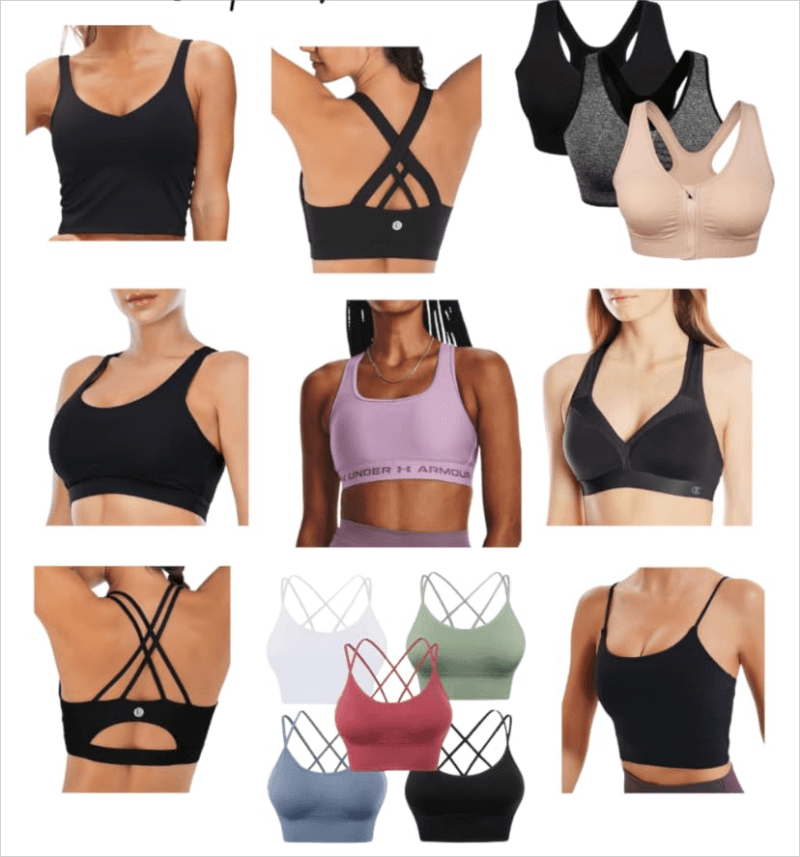Wearing the appropriate joga clothing is essential for both comfort and performance while practicing high-intensity yoga such Vinyasa, Ashtanga, or Power Yoga. The yoga bra is among the most crucial items of clothing. It offers the required support, komfort, and adaptability so practitioners may concentrate on their postures free from interruptions. With an eye toward their fit for high-intensity yoga motions and their main benefits, we will discuss the top 8 materials often used for yoga bras in this post.

Value of Materials in Yoga Bras
The whole comfort, oddychalność, and support of your yoga bra depend much on its material. This is especially true in demanding yoga sessions. Materials must be flexible to provide complete range of motion, breathable to help to keep perspiration away from your skin, and supportive to guarantee comfort during active motions. Every material has special qualities that satisfy certain yoga requirements.
Poliester: The Performable Material of Choice
Because polyester has outstanding moisture-wicking qualities, it is among the most often used fabrics in yoga bras. It keeps you dry even on the most intense yoga flows by drawing perspiration away from the skin and assisting in its evaporative process. Perfect for high-intensity exercises, polyester is also strong, elastyczny, and resistant to shrinking. Many yoga bras are constructed from a polyester and spandex combination that improves flexibility and support.
Elasticity and Comfort: Spandex/Elastane
Often blended with other materials like polyester or nylon to produce yoga bras with a tight, comfortable fit, spandex—also known as elastane—is renowned for its great stretchability. Maximum flexibility made possible by the material is crucial for doing difficult yoga postures free from constraint. Additionally helping the bra keep its form and provide long-lasting support throughout your practice is Spandex. High-intensity yoga is a common option for the lightweight fabric as it allows for unfettered mobility.
Nylon: Rough Finish and Durability
Another often used material in high-performance yoga bras is nylon. Renowned for its smooth smoothness and robustness, nylon provides great comfort and support. This cloth is ideal for yoga practices heavy in perspiration as it dries rapidly as well. While its sturdy character guarantees that the yoga bra keeps its shape even after repeated usage, its lightweight and gentle texture lower the danger of discomfort during activities. Furthermore contributing to the bra’s lifetime is nylon’s resistance to pilling and fading.
Tkanina bambusowa: Ecological Harmony
Bamboo fabric has become somewhat well-known in the field of yoga bras for individuals who favor environmentally friendly solutions. During heated yoga or other vigorous exercises, bamboo—a naturally breathable and moisture-wicking fabric—keeps you cool and dry. Additionally hypoallergenic, it’s an excellent choice for sensitive skin. Natural antibacterial qualities of bamboo fabric assist to stop odor build-up during extended practice sessions. Bamboo is also a sustainable resource, hence it’s a terrific option for those that care about the surroundings.
Bawełna: Breathability and softness
Often considered as the most comfortable fabric for daily use, cotton is also featured in yoga bras, especially for individuals who would want a more natural and airy material. Cotton absorbs moisture, which might be a disadvantage in high-intensity yoga even if it is very breathable and comfortable on the skin. To increase their performance in more active conditions, several contemporary cotton-blend textiles have been improved with moisture-wicking technology, niemniej jednak. For moderate to medium-intensity yoga or leisure wear, cotton is great.
Wełna Merino: Natural Temperature Control
Though its inherent moisture-wicking and temperature-regulating qualities make it a great option for high-intensity practice, merino wool may not be the first material that springs to mind when considering yoga bras. Merino wool keeps you warm in slower, restorative postures and cools you when you sweat; it is comfortable on the skin and helps maintain an ideal body temperature. Although merino wool’s lightweight quality and odor resistance make it appropriate for yoga, particularly in colder surroundings, it’s more usually connected with outdoor activities.
Recycled Resources: Sustainable Creativity
Yoga bras are produced using recycled materials more and more as many buyers still give sustainability first importance. By recycling plastic bottles and other materials, recycled polyester or nylon fabrics help to reduce waste. Though their environmental effect is much reduced, these recycled textiles keep the same quality, trwałość, and performance as their virgin counterparts. One great approach to mix high-performance with environmental awareness is to choose a yoga bra created from recycled materials.
Tencel (Lyocell): Silky, Sustainable Soft
Another environmentally friendly fabric increasingly used in yoga bras is tencel, often called lyocell. Made from sustainably derived wood pulp, Tencel’s silky smooth feel and moisture-wicking qualities are well-known. It’s also perfect for high-intensity yoga classes as it naturally contains antimicrobial qualities that aid to lower body odor. Being biodegradable, tencel is a great ecological substitute for synthetic materials. Perfect for high-performance yoga bras, it’s soft, przewiewny, and very absorbent.
Selecting the ideal material for your yoga practice
For high-intensity yoga, choosing a yoga bra should take into account elements like breathability, elastyczność, trwałość, and moisture-wicking properties. While fabrics like polyester and spandex give great support and performance, environmentally friendly choices include bamboo, wełna merynosów, and Tencel provide sustainable solutions without sacrificing comfort. Knowing the advantages and drawbacks of any material will enable you to choose with knowledge in line with your practice and taste.

Achieving the best comfort, wsparcie, and performance in high-intensity yoga requires selecting a yoga bra appropriate for that practice. Understanding the advantages each fabric provides will help you to choose the greatest match for your requirements from the many materials at hand. Whether your preferred yoga bra is a flexible spandex design, a moisture-wicking polyester mix, or an environmentally friendly bamboo fabric, the important thing is to choose one that supports your body during even the most difficult positions. More materials mean more options for a yoga bra that not only supports your movement but also fits with your environmental aims.



